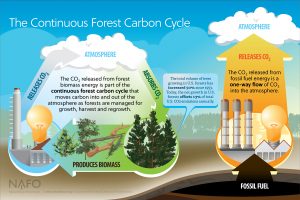Seeking to carve out an environmental legacy, the Obama Administration rolled out a major new policy addressing climate change on Aug. 3. However, the role of forest biomass in meeting carbon reduction requirements is still unclear.
The Clean Power Plan (CPP), a massive work of over 1,500 pages from the Environmental Protection Agency (EPA), focuses primarily on reducing carbon emissions from existing power plants. Important to forestry is language included in the CPP that recognizes forest biomass as a viable renewable energy source but at the same time the plan’s rules for the use of biomass raises uncertainties and complex questions.

The Plan sets an overall goal of reducing greenhouse emissions by 32 percent by 2030 from 2005 levels. Under the CPP, the EPA has set emission reduction targets for each state but allows the states the flexibility to determine how they will attain those targets through state plans but mandatory reductions must begin by 2022.
Under the CPP, “qualified biomass” is defined as biomass feedstock, such as wood, that is demonstrated to qualify as a method to control increases of carbon dioxide levels in the atmosphere. EPA projects that renewable energy sources—including “sustainably produced biomass”—will account for 28 percent of the nation’s power supply by 2030. This suggests that forest biomass could be a core contributor to carbon reduction goals.
However, the CPP rules fail to provide clarity on how forest bioenergy can be practically used by states to meet emission reduction goals.
“Foresters should be pleased with the recognition of forest biomass as a viable, renewable energy source, but as is often the case, there is a caveat,” said John Barnwell, director of government affairs and external relations at the Society of American Foresters, in the September issue of The Forestry Source. “Work is needed to further define what biomass feedstocks are acceptable in state implementation plans.”
“Although the EPA acknowledged biomass as a potential contributor to carbon reductions, the agency has yet to provide the endorsement needed for forest biomass to play a significant role in power plans submitted by early adopters of the new rule,” Barnwell said.
Other forestry organizations are also expressing concerns about the role of forest biomass in the new CPP rule.
Dave Tenny, president and CEO of the National Alliance of Forest Owners (NAFO), a major forestry group working on policy issues in Washington, said “CPP‘s approach to biomass is out of step with the prevailing view in Congress.”
“Instead of providing the clarity so badly needed at this critical juncture, the Clean Power Plan creates more process, complexity, and confusion that will only extend the uncertainty riddling the biomass community,” Tenny said.
“It [CPP] seems to disregard the strong bipartisan position of 200 Members of Congress in both the House and Senate urging EPA and other federal agencies to adopt a clear and simple policy on biomass carbon neutrality,” Tenny said. “It’s time for Congress to step in and affirm the carbon benefits of renewable forest biomass once and for all so forest owners, energy producers, and states can have the certainty they need.”
Tenny is referring to two separate but identical bipartisan letters signed by 46 Senators and 154 House members sent to the heads of EPA and the Departments of Agriculture and Energy over the summer urging them to “support biomass energy as a sustainable, responsible, renewable, and economically significant energy source.”
“Federal policies across all departments and agencies must remove any uncertainties and contradictions through a clear, unambiguous message that forest bioenergy is part of the nation’s energy future,” the letters state. “Federal policies that add unnecessary costs and complexity will discourage rather than encourage investment in working forests, harvesting operations, bioenergy, wood products, and paper manufacturing. Unclear or contradictory signals from federal agencies could discourage biomass utilization as an energy solution.”
Clouds over the CPP’s future are already gathering. Virtually all of the Republican presidential candidates have said they will eliminate CPP if elected. A Senate committee has approved a bill offered by Senators from coal-dominated West Virginia that would delay implementation of the plan pending judicial review. And the attorney generals from 16 states are calling on the Administration to delay the plan—a move seen as a precursor to legal action aimed at killing the plan.
But despite the current uncertainties concerning the use of forest biomass under the CPP, demand for wood as an alternative energy source continues to grow, providing viable local markets, and opportunities for landowners.
This article was originally published in the Fall 2015 Edition of the F&W Forestry Report.
Read More:
- National Alliance of Forest Owners: “It’s Time to Fix the Biomass Mess” →
- Georgia Forestry Association: Federal Issues and Action Items →

